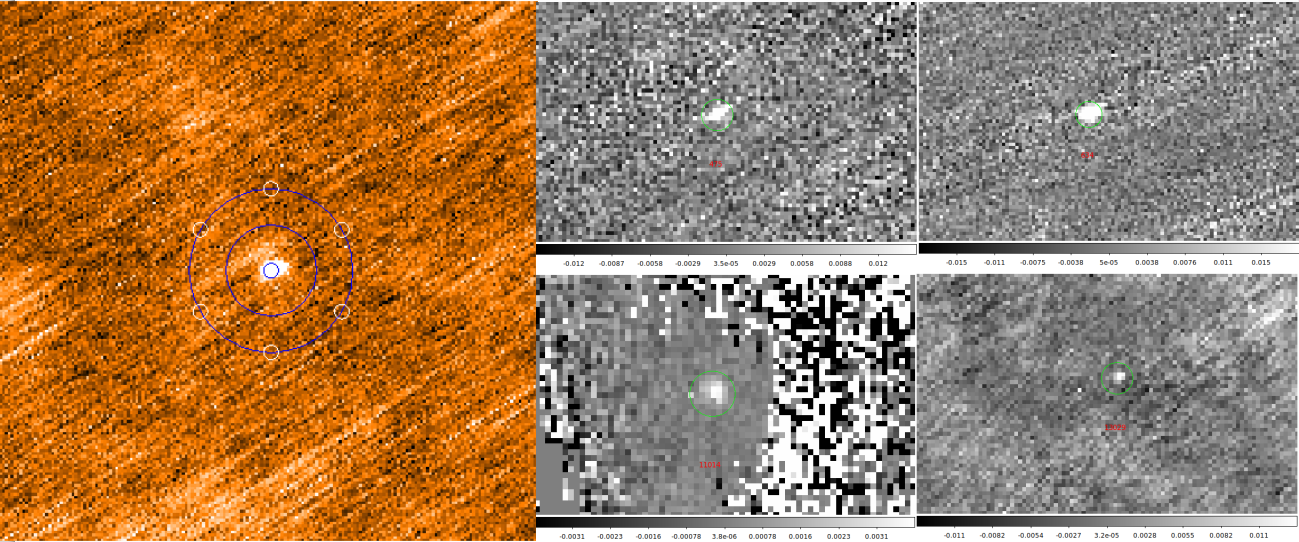Photometry of main belt asteroids from serendipitous Herschel/PACS observations
- 1Research Centre for Astronomy and Earth Sciences, Eötvös Loránd Research Network (ELKH), Konkoly Observatory, Budapest, Hungary (szakats.robert@csfk.org)
- 2MPE, Garching, Germany
The Herschel Space Observatory had two imaging instruments, working in the far-infrared and submillimetre regimes: the PACS cameras at 70/100 and 160 μm and the SPIRE photometers at 250, 350 and 500 μm. Small solar system bodies, especially main belt asteroids were serendipitously present in the field of view mainly in large scan maps. We identified these objects with the original aim to mark the affected sources in the Herschel PACS and SPIRE Point Source Catalogues. In our present study we are extracting flux densities in the PACS bands for asteroids above the detection limit, either using existing standard level 2 data products from the Herschel Science Archive, or re-reducing the PACS maps in the co-moving frame of the target.
We are performing aperture photometry on the PACS maps with the HIPE software, because it has all the necessary built-in functions and values for the aperture correction. To obtain high S/N flux densities we are using somewhat smaller aperture radii, namely 4, 5 and 8 arcsecs in blue, green and red bands, see Figure 1. For the faintest objects, where the S/N is below 10, we are using larger apertures of 6, 7, and 10 arcsec in radius, to get a higher encircled energy fraction. We are making a 5' cutout around the asteroid, which is being stored as a png file to allow us to make visual inspections of the source and its surroundings.
Using HIPE's annularSkyAperturePhotometry function we are performing the photometry, using the above mentioned aperture sizes and the built-in centroid algorithm. The initial coordinates are derived from RA and DEC values from JPL/Horizons. On the raw photometry results we perform the aperture correction with the photApertureCorrectionPointSource task, taking into account the band, the observation mode (parallel or not) and the scan speed. The centered aperture is also plotted on the cutout.
One of the most important and difficult task is to give a proper error estimation for the extracted fluxes. First, we are using the photometry error given by the HIPE tasks, and the coverage, to determine how much time the asteroid spent on the detector and assess the quality of the photometry. Finally we are adding 5 percent absolute flux calibration error.

Figure 1. Left: (16) Psyche in red band. The aperture for photometry, and the annulus for background estimation is plotted on the image, as well as the apertures for an alternative error estimation. Right: Four serendipitously observed asteroids on blue maps with no shape model and very limited or no thermal measurements. Left upper: (475) Ocllo, Left bottom: (11014) Svatopluk, Right upper: (634) Ute, Right bottom: (13029) 1989 HA
With this method we extracted 633 flux densities of 275 asteroids, on 272 maps, 229 in the blue band, 179 in the green and 225 in the red band.
Five of the serendipitously observed asteroids are mission targets, and are well known, e.g. (1) Ceres, (4) Vesta. 59 of them have shape model and sufficient multi-mission thermal measurements, e.g. (13) Egeria, (43) Ariadne, 12 have shape model, but very limited or no thermal measurements, e.g. (212) Medea, or (675) Ludmilla. In these cases the new flux densities can help confirming the existing shape model and to develop thermophysical models for the asteroids. 48 have sufficient multi-mission thermal measurements, but no shape models, e.g. (58) Concordia or (128) Nemesis. Finally, 19 asteroid from our work don't have shape model and has very limited or no thermal measurements, e.g. (475) Ocllo or (634) Ute, see Figure 1.
We are planning to publish the new fluxes and these new flux densities will be included in the Small Bodies: Near and Far (SBNAF) Infrared Database (Szakáts et al., 2020). The fluxes obtained from Herschel are excellent for radiometric studies to get the object's size, albedo and maybe also thermal properties, when combined with other measurements (Alí-Lagoa et al., 2020).
A natural continuation of our current work is the extension to SPIRE maps to find serendipitous asteroids, extract new submm fluxes and flag sources in the SPIRE Point Source Catalog for possible contamination. For those asteroids which have thermal emission data available at shorter wavelengths the Herschel PACS and SPIRE measurements allow us to determine the far infrared and submmm emissivities.
How to cite: Szakáts, R., Kiss, C., Müller, T., Alí-Lagoa, V., and Pál, A.: Photometry of main belt asteroids from serendipitous Herschel/PACS observations, European Planetary Science Congress 2021, online, 13–24 Sep 2021, EPSC2021-761, https://doi.org/10.5194/epsc2021-761, 2021.

